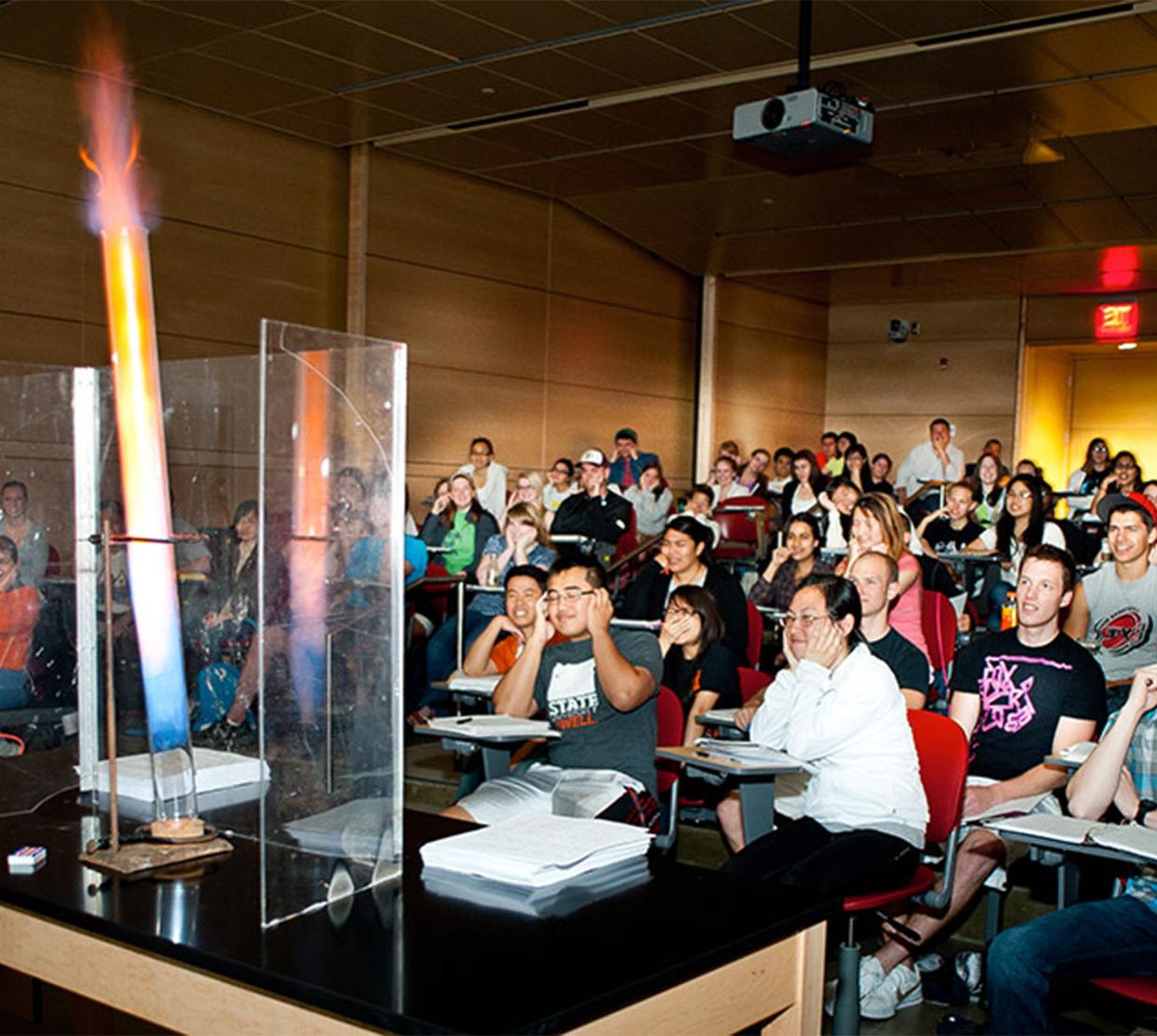If you ask Richard Nafshun, he’ll say that one of the quickest ways to get teenagers interested in chemistry is to put on a good show. The idea was foremost on his mind when he collaborated with local middle school teachers and Oregon State graduate students to put on the “Chemistry Show,” at the LaSells Stewart Center this spring.
And when upwards of 1200 middle-schoolers and their families showed up, he was glad he had made things interesting. The senior instructor of chemistry at Oregon State is passionate about teaching and outreach.
“We had lots of fun with exploding balloons,” he says. “So you take an uninflated balloon, hook it up to the hydrogen tank, and tie it off. You have it on a string, tape a candle to a meter stick, put the candle underneath the balloon… and BOOM!”
It wasn’t the only time sparks flew during the show’s 20 demonstrations, but for Nafshun, who holds both a master’s degree in science education and a Ph.D. in inorganic chemistry from Oregon State, the spectacle is only part of the process—learning is the other.
For the past 15 years, Nafshun has dedicated himself to creating better chemistry classes for students, especially in the lecture setting. He’s pioneered online chemistry education at Oregon State, created outreach programs for K-12 students and mentored the next generation of chemistry teachers and professors.
And he has been successful, too. Not only has Nafshun won numerous teaching awards, Oregon State students regularly approach Nafshun and tell him they remember his outreach events from their grade school or middle school years. Some even come back to volunteer with programs they experienced as grade schoolers.
“That’s a real cyclic thing,” he says. “To say, ‘Wow. You were in this program, and now you’re teaching where you’ve been taught. And you’re going to be a teacher in the future.’ It makes me feel wonderful.”
A Collaborative Experience
Nafshun discovered his passion for teaching when he was a chemistry undergraduate at California State University, Stanislaus. He was one of the few students there asked to serve as a teaching assistant—a rare thing at a university with no graduate program.
“I absolutely fell in love with being a teacher,” he says.
That love was further cemented when, that summer, Nafshun took a job working for a group that did cholesterol testing in eggs and dairy products. Although he saw value in the work, he wanted to be a part of something more collaborative.
“While the chance for development and research was there, it seemed very independent and isolated,” Nafshun says. “It didn’t seem as though I was going to be part of an institutional process to make something happen.”
Bringing passion to a profession
Now, Nafshun focuses his research on instructional methods for the large classroom, and teaches general chemistry. Many of the lessons he creates for the lecture hall reflect what he loved about chemistry as a high school student—group projects that rely on teamwork and exploration rather than rote memorization.
“It was all that time after school meeting with fellow students, and accomplishing a project and doing scholarship that I found fabulous,” he says.
Nafshun also mentors students in CH 607, his college chemistry-teaching seminar. He wants them to have the experience of engaging students in the lecture setting as well.
“We develop curriculum and labs. And then the beautiful part about it is these graduate students take over the class from one week,” Nafshun says. “So they work on a unit. They prepare. We talk about what demonstrations to do, teaching methods, everything.”
Since 1997 Nafshun has mentored nearly 20 students in the seminar setting—some of whom have gone on to use some of the methods Nafshun taught them at institutions like Evergreen, The Ohio State University, the University of Portland and Seattle Pacific, to name a few.
“I hope they’re bringing engaging instructional techniques, doing good student questioning and application-based instruction,” he says. “I hope that they’re focusing on students working in small groups. I honestly think there’s a balance in the lecture hall.”
A Home for Science
Nafshun’s input into the classroom experience isn’t the only thing that works for his students—the new Linus Pauling Science Center, which was completed in 2011, does as well. There are only seats for 178 students in the building’s lecture hall, which helps facilitate the application of some of Nafshun’s lecture content in introductory chemistry classes.
And because some of the Center’s cutting-edge research facilities like the electron microscopy lab and the nuclear magnetic resonance facility are on the main floor and encased in glass, students get a more immediate and exciting view of research in the moment.
“This year they’re coming out of the woodwork and asking about undergraduate research opportunities,” Nafshun says. “You walk down the hall and see fundamental research, stuff that matters today. Students see it, too.”
Access for Everyone
One of Nafshun’s more recent projects has been collaborating with colleagues in chemistry and computer science to develop a curriculum of general chemistry labs that are delivered online. They are currently being used in Oregon State’s Ecampus chemistry program, and Nafshun hopes that other universities might use the curriculum, too.
For Nafshun, online labs are the way of the future, and online education is a way for people to have access to education who wouldn’t otherwise, like deployed military personnel and people living in rural areas.
“I started the Ecampus chemistry program nine years ago, and saw the enrollment in the online program go from two students to 600 a term,” he says.
As for the next Chemistry Show, Nafshun is trying to figure out if there’s a venue in Corvallis that will hold an even bigger crowd.




